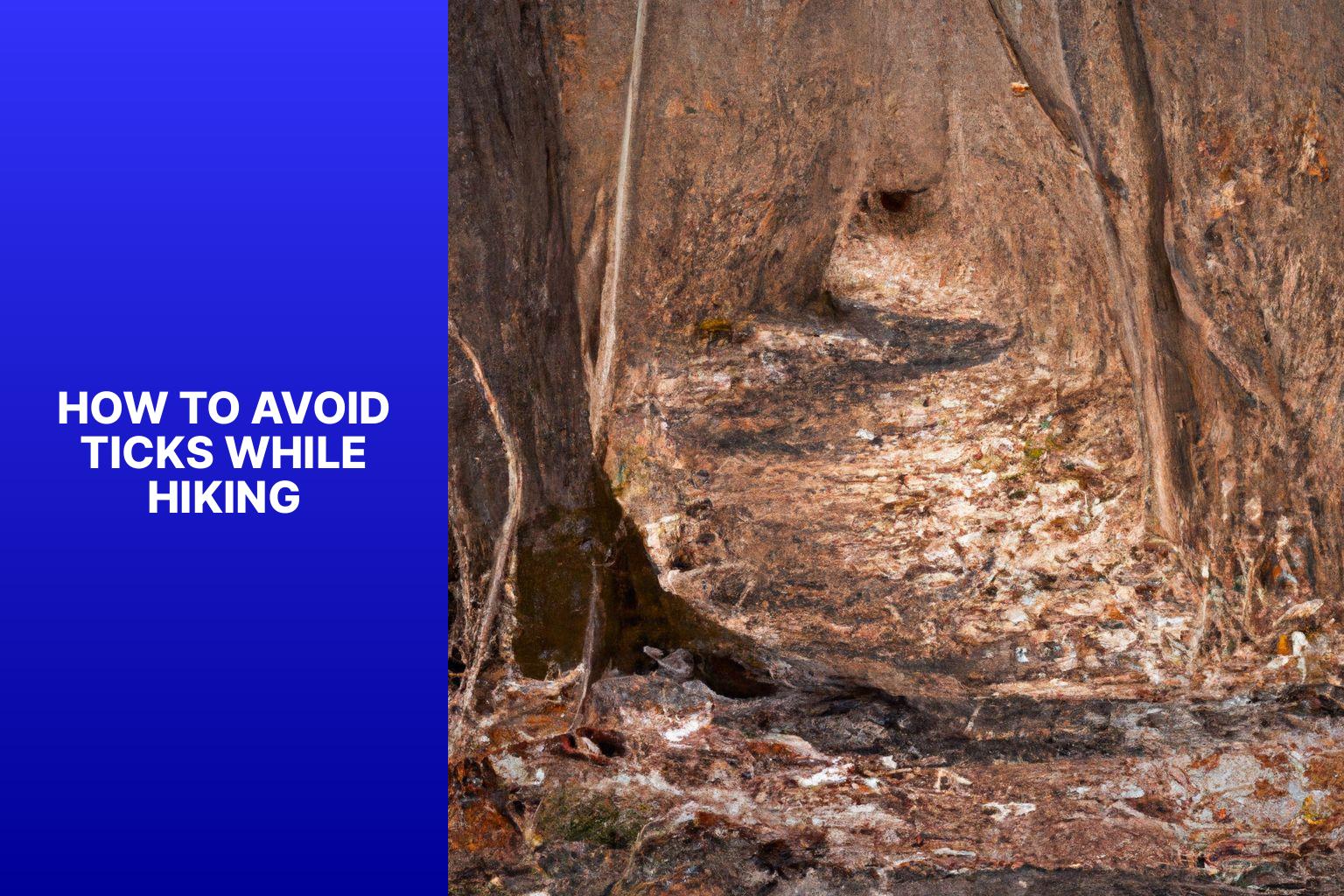How to Avoid Ticks While Hiking
Hiking is a popular outdoor activity that offers opportunities for adventure and exploration. It is important to be aware of the dangers posed by ticks in order to protect yourself while enjoying the great outdoors.
Ticks are notorious for carrying and transmitting various diseases, making tick prevention essential. Understanding the risks associated with ticks is the first step towards safeguarding your health.
Tick habitats can be found in certain environments and it is crucial to be able to identify these areas to minimize exposure. There are several effective tick prevention techniques that can be implemented, including dressing appropriately, using insect repellents, regularly checking for ticks, staying on designated trails, and avoiding tick-infested areas.
In the unfortunate event of a tick bite, knowing how to properly remove the tick is crucial. There are home remedies that can help alleviate the symptoms of tick bites. It is important to know when medical attention should be sought.
By following these guidelines and being proactive in tick prevention, you can ensure a safe and enjoyable hiking experience.
1. Tick prevention techniques are crucial: Dress appropriately, use insect repellents, check for ticks, stay on designated trails, and avoid tick-infested areas to minimize the risk of tick bites while hiking. 2. Proper tick removal is essential: Learn how to properly remove a tick to reduce the chances of infection or disease transmission. 3. Be aware of tick-borne diseases: Understand the dangers of ticks and the diseases they carry to recognize symptoms and know when to seek medical attention after a tick bite.
Understanding the Dangers of Ticks

Photo Credits: Jasonexplorer.Com by Alan Ramirez
Ticks pose a significant risk to humans due to their ability to transmit diseases such as Lyme disease, Rocky Mountain spotted fever, and Babesiosis. It is crucial to recognize and comprehend these dangers as they can seriously impact your well-being if left untreated. For instance, Lyme disease can lead to fatigue, joint pain, and even neurological complications.
To prevent tick-borne illnesses, it is essential to take precautions, especially in areas where ticks are prevalent. One should consistently wear long sleeves and pants, apply insect repellent containing DEET, and stick to marked trails to minimize the chances of tick bites.
It is vital to regularly check your body for ticks after spending time in tick-infested areas. Ticks have a propensity to attach themselves to warm and moist areas, such as the armpits, groin, and scalp. Promptly removing attached ticks can significantly reduce the risk of disease transmission.
Being aware of the symptoms associated with tick-borne illnesses is also crucial. If you experience flu-like symptoms, a rash, or any other unusual symptoms after a tick bite, it is imperative to seek medical attention immediately.
By gaining an understanding of the dangers posed by ticks and adopting the necessary precautions, you can minimize the risk of contracting tick-borne diseases while still enjoying outdoor activities. Stay well-informed, remain alert, and prioritize your health when it comes to tick safety.
What Diseases Do Ticks Carry?
Ticks carry a variety of diseases harmful to humans, including Lyme disease, Rocky Mountain spotted fever, babesiosis, anaplasmosis, and tularemia. These diseases are transmitted through the bite of an infected tick and can have serious health implications. It is crucial to be aware of the diseases that ticks carry, take necessary precautions, and seek medical attention if necessary.
Lyme disease is the most common tick-borne illness in the United States and can cause symptoms such as fever, fatigue, headache, muscle and joint aches, and swollen lymph nodes. Meanwhile, Rocky Mountain spotted fever can result in a high fever, headache, rash, and, in severe cases, organ failure. Babesiosis and anaplasmosis exhibit similar symptoms to Lyme disease, while tularemia can lead to fever, skin ulcers, and swollen lymph nodes.
It’s important to note that not all ticks carry diseases, and the risk of contracting a tick-borne illness can vary depending on the location and type of tick. Therefore, taking preventative measures like wearing protective clothing, using insect repellents, and conducting regular tick checks after outdoor activities in tick-infested areas is crucial to minimize the risk.
Tick-borne diseases have been on the rise, particularly in regions with a high population of ticks. With the increase in outdoor activities and the expansion of tick habitats due to climate change, it is vital to stay informed and protect ourselves from tick bites. Public health agencies and organizations are actively working to raise awareness and develop strategies to combat these diseases. It is of utmost importance for individuals to educate themselves and take necessary precautions. By remaining vigilant and following guidelines, we can significantly reduce the risk of tick-borne diseases and safely enjoy the outdoors.
Identifying Tick Habitats
To successfully identify tick habitats while hiking, it is essential to have knowledge about the specific environments where ticks are frequently found. These habitats primarily comprise of wooded areas that have dense vegetation, tall grassy fields, as well as areas with leaf litter or fallen logs. It should be noted that ticks are most commonly found in regions that have high levels of humidity and an abundance of wildlife, particularly deer and mice.
To exercise caution while hiking in tick habitats, it is crucial to remember that ticks are most active during the warmer months, typically from spring through fall. Therefore, it is important to be vigilant during these times. When venturing through wooded areas or tall grassy fields, it is advisable to stay on designated trails in order to minimize direct contact with areas infested by ticks.
Areas with leaf litter are known to be common locations where ticks can be found, as they use it as a protective covering. In order to reduce the risk of encountering ticks, it is best to avoid sitting or lying down on the ground in these areas. Caution should be exercised when crossing over fallen logs or branches, as ticks may be present in such places.
In order to effectively minimize the risk of tick bites while hiking, it is important to regularly check for ticks after spending time in tick habitats. It is recommended to thoroughly inspect your clothing, gear, and exposed skin, paying close attention to areas such as the scalp, behind the ears, and the backs of knees. If you happen to find a tick attached to your skin, it is crucial to carefully remove it using tweezers, grasping it as close to the skin as possible, and pulling upwards with steady pressure.
By being fully aware of tick habitats and taking the necessary precautions, you can significantly reduce your risk of experiencing tick bites while hiking and ensure a safe and enjoyable outdoor experience.
Tick Prevention Techniques
When it comes to enjoying the great outdoors, there’s one pesky problem that can put a damper on your hiking adventure – ticks. In this section, we’ll arm you with essential tick prevention techniques, helping you stay tick-free while exploring nature’s wonders. From dressing appropriately to using insect repellents, checking for ticks, and staying on designated trails, we’ve got you covered. Get ready to hike worry-free and avoid those tick-infested areas along the way!
Dressing Appropriately
When embarking on a hiking adventure, it is of utmost importance to dress in a manner that is conducive to preventing ticks. Consider the following key factors:
-
Cover up: It is advisable to don long-sleeved shirts, long pants, and high socks to minimize the amount of exposed skin. Ticks are less inclined to attach themselves to clothing rather than bare skin.
-
Opt for light-colored clothing: Light-colored garments facilitate the detection of ticks that may be crawling on your attire. In contrast, dark-colored ticks are more discernible against light-colored clothing.
-
Secure your clothes: Ensuring that your pants are tucked securely into your socks and your shirt is tucked into your pants establishes a barrier that makes it arduous for ticks to crawl beneath your garments and reach your skin.
-
Choose fabrics with a tight weave: Opt for clothing made of tightly woven fabrics to impede ticks from breaching the material. Conversely, avoid thin mesh materials that can be easily penetrated by ticks.
-
Employ tick repellent: Apply a repellent on both exposed skin and clothing to provide an added layer of protection. Look for repellents containing DEET or picaridin, as they have proven efficacy against ticks.
Keep in mind that no method can guarantee complete protection, therefore it is vital to regularly inspect both yourself and your clothing for ticks throughout and after your hike. Prompt and proper removal of ticks reduces the risk of contracting tick-borne diseases.
Pro-tip: Consider treating your clothing with permethrin, an insecticide that repels and eliminates ticks. This treatment remains effective for numerous washes, offering enduring protection while hiking.
Using Insect Repellents
During World War II, the use of insect repellents became essential in safeguarding soldiers from diseases transmitted by ticks and mosquitoes. In order to repel ticks effectively, the U.S. military formulated Repellent No. 3535, which contained DEET as its active ingredient. DEET has proven to be highly efficient in repelling ticks, mosquitoes, and other biting insects. This breakthrough in insect repellent development revolutionized the field, granting soldiers the ability to venture into tick-infested areas without apprehension.
Following its military triumph, DEET became readily available to the general public in the 1950s and has since remained the benchmark for effective insect repellents. In addition to DEET, picaridin and oil of lemon eucalyptus have gained popularity as effective repellents.
Continuous research and development in the realm of insect repellents have ensured that outdoor enthusiasts can indulge in their activities without the fear of tick-borne diseases. Technological advancements in repellent formulas, coupled with the promotion of proper usage, have significantly reduced the risk of exposure to ticks and the diseases they carry.
Checking for Ticks
When spending time outdoors and hiking, it is crucial to incorporate checking for ticks into your routine to prevent tick-borne diseases. To effectively check for ticks, follow these steps:
– Carefully examine your clothing for any crawling ticks, paying close attention to areas where ticks tend to hide, such as cuffs, collars, and seams.
– Thoroughly inspect your body for ticks, including difficult-to-reach areas like the back of your knees, scalp, and underarms. You can utilize a handheld mirror or seek assistance if needed.
– Gently feel your skin for any unusual bumps or itching sensations, as ticks can be very small. Run your fingers delicately over your skin to detect any attached ticks.
– If you discover a tick, use fine-tipped tweezers to remove it. Remember to pull the tick upward without twisting or jerking, and dispose of it in a sealed container or by flushing it down the toilet.
– After performing a thorough check for ticks, remember to wash your hands and the area where the tick was found with warm water and soap.
Pro-tip: When hiking, it is advisable to wear light-colored clothing. This makes it easier to spot any ticks crawling on your clothes.
Staying on Designated Trails
Staying on designated trails while hiking in tick-prone areas reduces the risk of tick encounters and potential bites. Follow these steps to stay on designated trails:
1. Research and plan your hiking route in advance to find designated trails.
2. Have a map or guidebook with clear markings of the trails.
3. Follow trail markers or signs indicating the designated path.
4. Avoid venturing off the trail into dense vegetation or grassy areas.
5. Stick to the center of the trail, avoiding contact with tall grass, shrubs, or overhanging branches.
6. Stay aware of your surroundings and ensure you remain on the designated trail.
7. Refer to your map or guidebook when encountering trail intersections or forks to stay on the designated path.
8. Avoid taking shortcuts or creating new paths through vegetation, as this disturbs the natural habitat and increases the risk of encountering ticks.
9. Whenever you encounter obstacles like fallen trees or rocks, navigate around them while staying on the designated trail.
10. Respect the environment and practice proper trail etiquette by leaving no trace behind.
By adhering to the designated trails, you minimize the risk of coming into contact with ticks and decrease the chances of tick-borne diseases. Remember to also follow other tick prevention techniques, such as appropriate dressing and checking for ticks after hiking, for comprehensive protection.
Avoiding Tick-Infested Areas
Minimize the risk of encountering ticks by implementing strategies to avoid tick-infested areas. Follow these tips to effectively accomplish this:
1. Start by researching local tick hotspots. Gain knowledge about areas that have high tick activity, such as wooded or grassy areas, dense vegetation, and locations frequented by wildlife.
2. When venturing into tick-prone areas, stay on designated trails. It is essential to stick to well-maintained paths and avoid venturing into tall grasses, bushes, or underbrush where ticks tend to hide.
3. Another important strategy is to avoid tick habitats. Ticks flourish in moist and shaded environments. Therefore, it is crucial to steer clear of leaf litter, fallen logs, or overgrown areas that provide a suitable habitat for ticks.
4. During the peak tick seasons of spring and summer, taking extra precautions is vital. Limit your exposure by wearing protective clothing, using tick repellents, and conducting regular tick checks.
5. Creating a tick-free zone around your home is advisable. Ensure your lawn is well-maintained by regularly mowing it and removing leaf debris. Clear any vegetation around the perimeter of your yard to minimize tick habitats.
While these strategies significantly reduce the risk of encountering ticks, it’s important to remain vigilant. After spending time in nature, always conduct regular tick checks.
Remember, ticks are attracted to warm and moist areas on the body, making the scalp, armpits, and groin particularly susceptible to tick bites.
Tick Removal Methods
To minimize the risk of infection, it is important to use tick removal methods correctly. Here are some effective tick removal methods:
- Use fine-tipped tweezers to grasp the tick as close to the skin as possible.
- Gently pull upward with even pressure. Avoid twisting or jerking the tick to prevent the mouthparts from breaking off and remaining in the skin.
- If the tick’s mouthparts break off, use the tweezers to remove them. If unable, clean the area with rubbing alcohol or soap and water.
- After removing the tick, clean the bite area and your hands with rubbing alcohol or soap and water.
- Dispose of the tick by flushing it down the toilet or placing it in a sealed bag or container.
- Monitor the bite area for redness, swelling, or infection. Seek medical attention if you experience symptoms like fever, rash, or flu-like symptoms.
- Record the date of the tick bite and observe your health for a few weeks, as some tick-borne illnesses may take time to develop.
A true story emphasizes the importance of proper tick removal methods. A friend noticed a tick on her leg while hiking. She followed the Tick Removal Methods above to safely remove the tick and monitored the bite area. A week later, she developed flu-like symptoms and sought medical attention. It was determined that she had contracted Lyme disease from the tick bite. With prompt treatment, she fully recovered. This story highlights the need for caution when dealing with ticks and the importance of proper removal techniques to reduce the risk of tick-borne illnesses.
How to Properly Remove a Tick?
Removing a tick properly is crucial to reduce the risk of infection or disease transmission. Here’s a step-by-step guide on how to properly remove a tick:
1. Prepare: Wear disposable gloves to protect yourself from potential pathogens carried by the tick.
2. Use tweezers: Grasp the tick as close to your skin as possible, ensuring a firm grip.
3. Gently pull: Slowly and steadily remove the tick straight out with even pressure. Avoid twisting or jerking movements.
4. Check for mouthparts: After removal, carefully inspect the tick to ensure no mouthparts are left in your skin.
5. Clean the area: Wash the bite site with soap and water, then apply an antiseptic to prevent infection.
6. Dispose of the tick: Place the tick in a sealed bag or container, or flush it down the toilet. Do not crush the tick with your fingers to avoid contact with pathogens.
7. Monitor for symptoms: Watch for any signs of infection or illness, such as a rash or fever. If symptoms develop, seek medical attention.
By following these steps, you can safely and effectively remove a tick from your skin. If you are unsure about the removal process or unable to remove the tick completely, it is best to seek medical assistance.
Home Remedies for Tick Bites

Photo Credits: Jasonexplorer.Com by Larry Torres
When dealing with tick bites, it’s important to try these natural home remedies for tick bites in order to alleviate symptoms and promote healing. First, make sure to clean the bite area using soap and water to remove any dirt and bacteria.
Next, carefully remove the tick by using fine-tipped tweezers to firmly grasp the tick and pull upward with steady pressure. It’s important to avoid twisting or jerking the tick to prevent leaving any mouthparts in the skin.
After removing the tick, apply a cold compress or ice pack wrapped in a cloth to the bite area for about 15 minutes. This will help reduce pain and inflammation. You can apply an over-the-counter antibiotic ointment, such as Neosporin, to the bite to prevent infection. Just make sure to follow the instructions on the packaging.
If the tick bite causes pain or discomfort, you can take over-the-counter pain relievers like acetaminophen or ibuprofen, following the recommended dosage. It’s crucial to monitor the bite area for signs of infection. If you notice increasing redness, swelling, warmth, or pus, it’s important to seek medical attention.
In case you experience fever, headache, muscle aches, or develop a rash, these may be signs of tick-borne diseases. In such cases, it’s advisable to consult a healthcare professional for further evaluation and guidance. Remember, while these home remedies can provide relief and aid in healing, they do not replace proper medical care. If you have any doubts or concerns about a tick bite, it’s always best to consult a healthcare professional for proper diagnosis and treatment.
When to Seek Medical Attention

Photo Credits: Jasonexplorer.Com by Zachary Smith
When to Seek Medical Attention
While hiking, it is important to know when to seek medical attention for health issues or injuries. Seek medical attention immediately if you experience severe pain or a sudden, intense headache. These symptoms could indicate a serious condition like a concussion or head injury. Treat any signs of an allergic reaction (difficulty breathing, swelling of the face or throat, hives) as an emergency and seek medical help right away.
Seek medical attention if you encounter a tick bite and develop symptoms like a rash, fever, or joint pain. These symptoms could be indications of a tick-borne illness such as Lyme disease. Early treatment is crucial in preventing complications.
If you have persistent or worsening pain, especially in the joints or muscles, consult a doctor. This could be a sign of a sprain, strain, or overuse injury that requires medical intervention.
Evaluate any open wounds that are deep, bleeding excessively, or showing signs of infection (redness, warmth, pus) with a healthcare professional. Proper cleaning, sutures if necessary, and antibiotics may be required.
Remember, it is always better to err on the side of caution when it comes to your health. If you are unsure whether to seek medical attention, consult a healthcare provider for guidance. Taking prompt action ensures your safety and well-being while hiking.
Frequently Asked Questions
How can I avoid ticks while hiking?
To avoid ticks while hiking, it is recommended to:
- Stick to rocky trails and avoid overgrown grassy areas
- Use bug spray, especially on the lower body, to repel ticks
- Treat clothes with permethrin to keep ticks away
- Cover up with long pants and long-sleeved shirts to prevent ticks from latching onto the skin
- Wear light-colored clothing to make it easier to spot ticks
- Tuck clothing in to minimize access for ticks
- Perform tick checks on yourself, others, and pets after hiking
What diseases can ticks transmit?
Ticks can transmit various diseases including:
- Lyme disease
- Rocky Mountain spotted fever
- Alpha-gal syndrome
- Ehrlichiosis
- Tularemia
- STARI (Southern tick-associated rash illness)
What are the common tick species and where are they found in Virginia?
In Virginia, the most common tick species are:
- Lone star tick (found mostly east of the Blue Ridge Mountains)
- American dog tick (found mostly west of the Blue Ridge Mountains)
- Brown dog tick
- Deer tick (most often found in the northern and eastern sections of the state)
How do I properly remove a tick?
To properly remove a tick:
- Use fine-nosed tweezers or tick removal tool
- Grasp the tick as close to the skin’s surface as possible
- Pull upward with steady pressure until the tick detaches
- Clean the bite area and hands with rubbing alcohol or soap and water
- Monitor symptoms after a tick bite and seek medical attention if needed
How can I protect my dog from ticks while hiking?
To protect your dog from ticks while hiking:
- Use tick repellent made specifically for dogs
- Keep your dog in the center of the trail
- Thoroughly check your dog for ticks before entering your home or car
- Treat your dog with preventative medication
What natural tick repellents are effective?
Natural tick repellents, such as those made from oil of lemon eucalyptus or other essential oils, can be effective in repelling ticks. It is recommended to also use CDC-recommended repellents containing DEET, picaridin, or oil of lemon eucalyptus for stronger protection.







